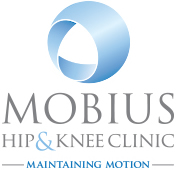
Total hip replacement
The hip is a ball-and-socket joint. The socket is formed by the acetabulum and the ball is the femoral head. The bone surfaces of the ball and socket are covered with articular cartilage - a smooth tissue that cushions the ends of the bones and enables them to move easily. In a healthy hip, the synovial membrane makes a small amount of fluid that lubricates the cartilage and eliminates almost all friction during hip movement. Bands of tissue called ligaments (the hip capsule) connect the ball to the socket and provide stability to the joint.
The most common cause of chronic hip pain and disability is arthritis. Osteoarthritis, rheumatoid arthritis, and avascular necrosis are the most common forms of this disease.
People who benefit from total hip replacement often have:
- Severe hip pain that limits everyday activities, including walking, climbing stairs, and getting in and out of chairs
- Moderate or severe hip pain while resting, either in the day or night
- Chronic hip inflammation and swelling that does not improve with rest or medications
- Failure to substantially improve with other treatments such as anti-inflammatory medications, hip injections, physiotherapy, or other surgeries including hip arthroscopy.
There are no particular weight bearing restrictions for uncomplicated total hip replacement surgery. Most patients who undergo total hip replacement are aged 45 to 85, but we evaluate patients individually.
Total hip replacement is usually performed under general anaesthesia. There are four basic steps to a hip replacement procedure.
- The damaged femoral head is removed and replaced with a metal stem that is placed into the hollow centre of the femur. The femoral stem may be either cemented or press fit (thightly fitted) into the bone.
- A metal (or sometimes ceramic – depending on the patient’s condition) ball is placed on the upper part of the stem. This ball replaces the damaged femoral head that was removed.
- The damaged cartilage surface of the socket (acetabulum) is removed and replaced with a metal bsocket. Screws or cement are sometimes used to hold the socket in place.
- A plastic spacer is usually inserted between the new ball and the socket to allow for a smooth gliding surface.
The procedure itself takes approximately 1 to 2 hours. After surgery, you will be moved to the recovery room, where you will remain for several hours while your recovery from anaesthesia is monitored. After you wake up, you will be taken to your hospital room.
The complication rate following total hip replacement is low. Serious complications, such as a hip joint infection, occur in fewer than 2% of patients (in our practice, fewer than 1.5%). Infection may occur in the wound or deep around the prosthesis. This may occur while in the hospital, after you go home or even many years later. Minor infections in the wound area are generally treated with antibiotics. Major or deep infections may require more surgery and removal of the prosthesis. Any infection in your body can spread to your joint replacement. Blood clots in the leg veins are one of the most common complications of hip replacement surgery. These clots can be life-threatening if they break free and travel to your lungs.
We will outline a prevention program, which may include periodic elevation of your legs, lower leg exercises to increase circulation, support stockings, and medication to thin your blood. After surgery, you may be prescribed one or more measures to prevent blood clots and decrease leg swelling. Foot and ankle movement also is encouraged immediately following surgery to increase blood flow in your leg muscles to help prevent leg swelling and blood clots.
Also, sometimes after a hip replacement one leg may feel longer or shorter than the other. We will make every effort to make your leg lengths even, but may lengthen or shorten your leg slightly to maximise the stability and biomechanics of the hip.
In addition, dislocation occurs when the ball comes out of the socket. The risk of dislocation is greatest in the first few months after surgery while the tissues are healing. If the ball does come out of the socket, a closed reduction can usually put it back into place without the need for more surgery. In situations in which the hip continues to dislocate, further surgery may be necessary.
Despite the recent advances in surgical techniques and implant designs and materials, implant surfaces may wear down and the components may loosen.
Notify us immediately if you develop any of the following warning signs:
Warning signs of blood clots:
- Increasing pain in your calf
- Tenderness or redness in the leg
- New or increasing swelling in your calf, ankle, and foot
Warning signs of pulmonary embolism:
- Sudden shortness of breath
- Sudden onset of chest pain
- Localised chest pain with coughing
Warning signs of infection:
- Persistent fever
- Shaking chills
- Increasing redness, tenderness, or swelling of the hip wound
- Drainage from the hip wound
- Increasing hip pain with both activity and rest
Exercise is a critical component of home care, particularly during the first few weeks after surgery. You should be able to resume most normal activities of daily living within 3 to 6 weeks following surgery. Some pain with activity and at night is common several weeks after surgery. Most people resume driving approximately 4 to 6 weeks after surgery.
Most people feel some numbness in the skin around their incision, it often diminishes with time and most patients find them to be tolerable when compared with the pain and limited function they experienced prior to surgery.





